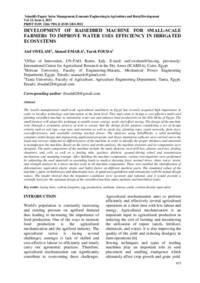Development of Raisedbed Machine for Small-Scale Farmers to Improve Water Uses Efficiency in Irrigated Ecosystems

Authors:
The locally manufactured small-scale agricultural machinery in Egypt has recently acquired high importance in order to localize technology and innovation at the farm level. This study aims to design a cost-effective multi-seed planting raisedbed machine to rationalize water use and enhance land productivity in the Nile Delta of Egypt. The small farmers will adopt this technique to enable water, energy, seeds, and effort saving. The design of the machine went through a systematic process of tests to ensure that the design fit for purpose considering a set of design criteria such as soil type, crop type, and varieties as well as seeds size, planting rates, roads networks, farm sizes, cost-effectiveness, and available existing traction forces. The analyses using SolidWorks, a solid modelling computer-aided design and engineering application program, and Ansys simulation software were carried out to the loads and stresses subjected to different parts of the machine in order to identify the proper thickness and materials to manufacture the machine. Based on the stress and strain analysis, the machine structure and its components were designed. The main components of the machine include the main skeleton, seed drill box, planter seed box, feeding chambers, and cells as well as a feeding tube, gearbox, ditchers, ground-driving wheel and transmission mechanism, and mounting triangle. After building the machine components, various investigations were performed by subjecting the used materials to ascending loads to analyze shearing force, normal stress, shear stress, strain, and strength analysis in a micro meshes scale in all machine components. These tests enabled the identification of deformations, equivalent elastic strain, and Safety factor on different machine parts. The simulated values of the machine’s parts in thicknesses and dimensions were in good correspondence and consistency with the actual design values. The model showed that the boundary conditions were accurate and rational, and it would provide a scientific basis for the optimum design of the raisedbed machine under multiple and interlinked loads.
